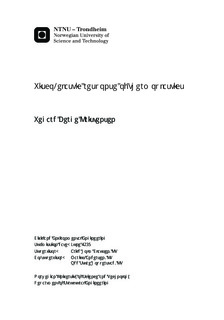| dc.contributor.advisor | Clausen, Arild Holm | nb_NO |
| dc.contributor.advisor | Andersen, Marius | nb_NO |
| dc.contributor.advisor | Hopperstad, Odd Sture | nb_NO |
| dc.contributor.author | Kristensen, Vegard Berge | nb_NO |
| dc.date.accessioned | 2014-12-19T12:02:29Z | |
| dc.date.available | 2014-12-19T12:02:29Z | |
| dc.date.created | 2013-09-19 | nb_NO |
| dc.date.issued | 2013 | nb_NO |
| dc.identifier | 649749 | nb_NO |
| dc.identifier | ntnudaim:9973 | nb_NO |
| dc.identifier.uri | http://hdl.handle.net/11250/237268 | |
| dc.description.abstract | In this study a recently developed visco-elastic visco-plastic material model has been evaluated with the intention of improving the simulated behaviour of polymers. In order for polymers to become a more reliable construction material the behaviour has to be rendered realistically in simulations. A set of eleven experimental tests have been conducted to establish a database for further simulations. By use of some of these experimental tests the visco-elastic visco-plastic material model has been calibrated. In addition a purpose developed Matlab program based on a uni-axial tension case of the material model served to evaluate the response of the experimental tests. Although a visco-elastic visco-plastic material model was employed, it was impossible to recreate the magnitude of the relaxation and creep in the experimental tests for large deformations. A modified visco-elastic visco-plastic material model with the network stress as a function of plastic strain instead of total strain, was therefore proposed and implemented in Matlab. This new model was able to simulate the response for large deformations. However, new calibrations had to be carried out for each of the different stress-strain domains in order to give an accurate response. Introducing more Maxwell-elements in the visco-elastic part of the model did not help significantly, as more elements just gave a smoother response. None of the material models presented was able to simulate the unloading procedure for all the different parts of the stress-strain domain based on one optimized calibration. A calibration of the models fitted to the elastic domain was too stiff in the early plastic domain, and too soft for large deformations. | nb_NO |
| dc.language | eng | nb_NO |
| dc.publisher | Institutt for konstruksjonsteknikk | nb_NO |
| dc.title | Visco-elastic response of thermoplastics | nb_NO |
| dc.type | Master thesis | nb_NO |
| dc.source.pagenumber | 178 | nb_NO |
| dc.contributor.department | Norges teknisk-naturvitenskapelige universitet, Fakultet for ingeniørvitenskap og teknologi, Institutt for konstruksjonsteknikk | nb_NO |

